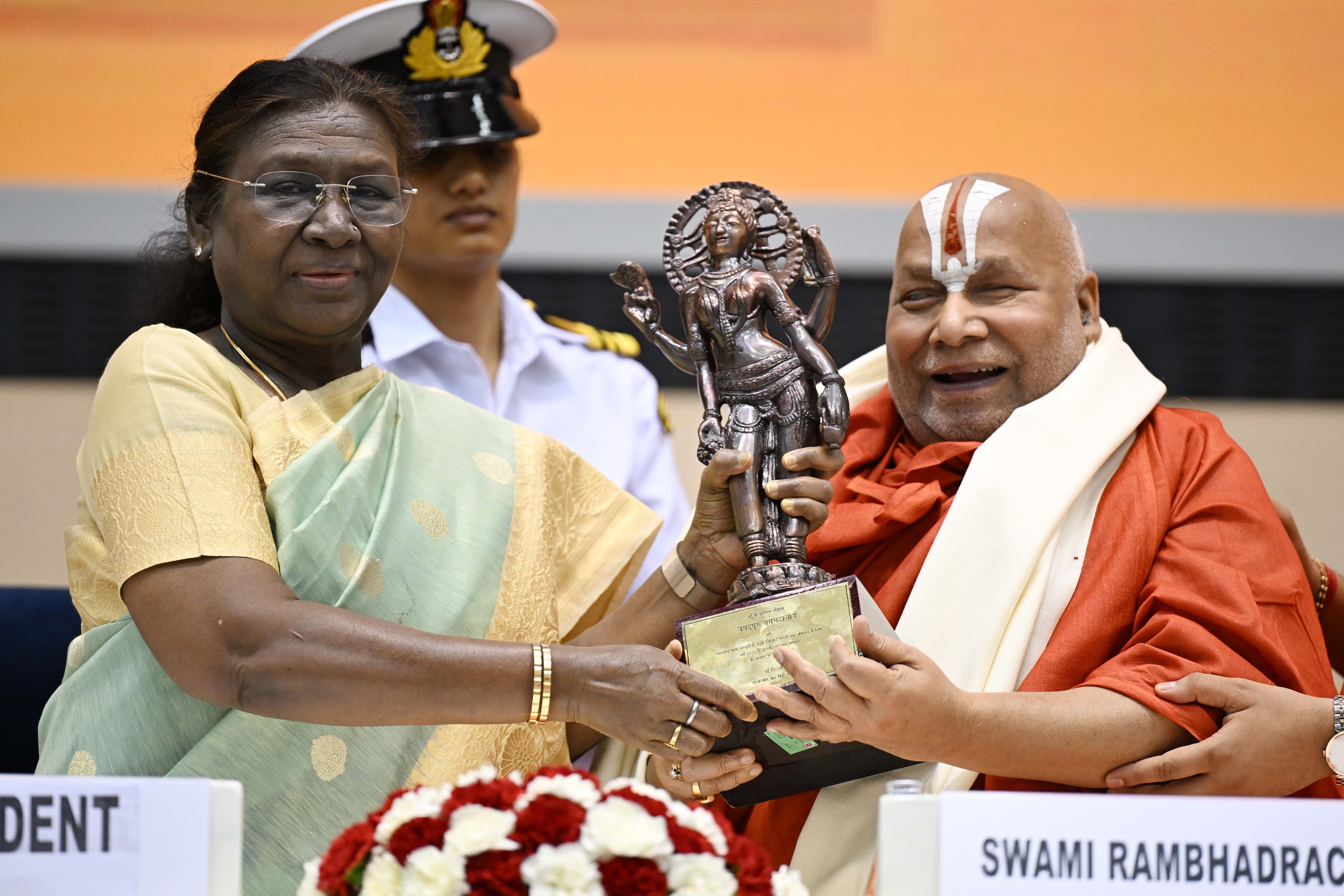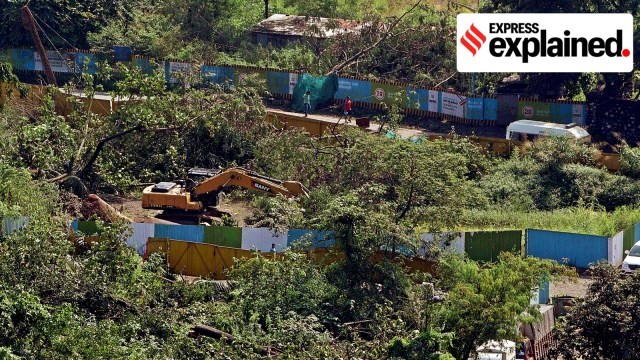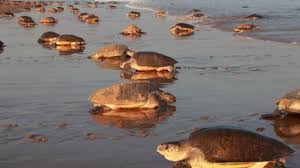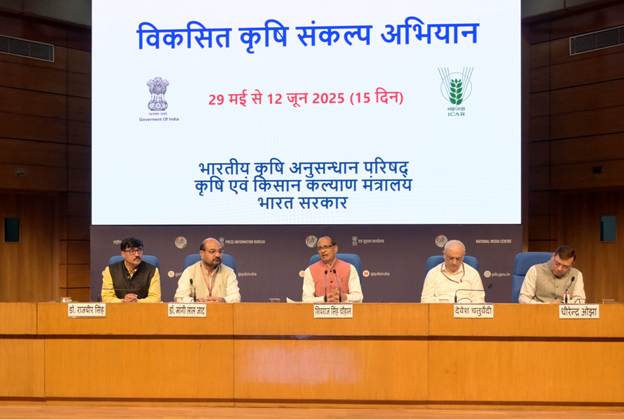58thJnanpith Award Conferred

- 20 May 2025
In News:
Recently, the President of India, presented the 58thJnanpith Award to renowned Sanskrit scholar Jagadguru Rambhadracharya Ji at a function held at Vigyan Bhavan, New Delhi. She also extended congratulations to celebrated writer Gulzar, a fellow recipient who could not attend due to health reasons.
About Jagadguru Rambhadracharya
- A prominent Sanskrit scholar, spiritual leader, poet, and educationist.
- Despite being visually challenged, he has made significant literary and social contributions.
- Recognized for his multi-faceted excellence in Sanskrit literature and devotion to nation-building through literary and cultural service.
Highlights from the President’s Address
- Emphasized that literature unites and awakens society, playing a key role in movements from 19th-century social reform to the freedom struggle.
- Referenced the literary legacy of figures like Valmiki, Vyas, Kalidas, and Rabindranath Tagore as embodiments of India’s civilizational essence.
- Praised the BharatiyaJnanpith Trust for honoring literary excellence since 1965 across various Indian languages.
- Celebrated the contributions of women Jnanpith awardees such as Ashapurna Devi, Amrita Pritam, Mahasweta Devi, and Pratibha Ray, urging young women to draw inspiration from their works.
About the Jnanpith Award
Feature Details
Established 1961
First Awarded 1965 to Malayalam poet G. SankaraKurup for Odakkuzhal
OrganisedBy BharatiyaJnanpith, a literary and cultural organization founded in 1944
Eligibility Indian citizens writing in Schedule VIII languages of the Constitution or
in English
Award Components Cash prize, citation, and a bronze replica of Vagdevi (Saraswati)
Nature Annual, but may be withheld if no suitable candidate is found
One-Time Recognition A writer can receive the award only once
Language Rotation Rule A language that has received the award is ineligible for the next two years
New Calcedonia
- 20 May 2025
In News:
For decades, New Caledonia, a French island territory of approximately 2,71,400 people in the southwest Pacific Ocean, has been on a complex journey regarding its status.
Geography and Strategic Significance
- Location: South Pacific Ocean, ~1,500 km east of Australia.
- Status: French overseas territory; part of EU’s Overseas Countries and Territories (OCTs), but outside the Euro and Schengen zones.
- Key Resources: Holds ~25% of the world’s nickel reserves.
- UNESCO Heritage: Lagoons and coral reefs recognized in 2008.
- Capital: Nouméa
Demographics (2019 Census)
- Population: ~2,71,400
- Indigenous Kanaks: ~39%
- Others: European, Polynesian, Vietnamese, Indonesian, Algerian descent.
Historical Timeline
- 1853: France annexes the islands; becomes a penal colony.
- 1957: French citizenship granted to all residents.
- 1980s: Ethnic tensions escalate; near civil war.
- 1988: Matignon Agreements signed.
- 1998: Nouméa Accord grants wide autonomy, New Caledonian citizenship, and promised three referendums on independence.
Independence Referendums
- 2018 & 2020: Majority voted against independence.
- 2021: Final vote boycotted by pro-independence groups (FLNKS) citing COVID-19 and customary mourning; outcome rejected as illegitimate.
Recent Crisis (2024)
- Trigger: French proposal to “unfreeze” electoral rolls to include newer residents.
- Consequence: Violent riots, 14 deaths, and widespread unrest.
- Talks Collapse: May 2024 negotiations failed due to rejection of the “sovereignty in partnership” proposal by loyalists.
Sovereignty-in-Partnership Proposal
- Envisioned enhanced self-rule with international recognition.
- Power would be delegated back to France in certain domains (e.g., judiciary).
- Rejected by loyalists as “disguised independence”.
Alternate Proposal by Loyalists
- Partition Model:
- Pro-independence North & Loyalty Islands – special status
- Wealthier, loyalist South Province – remain French
- Rejected by all sides:
- France – violates territorial integrity.
- FLNKS – compared it to apartheid.
What Lies Ahead?
- Provincial Elections due by November 2025.
- No political consensus on institutional status raises concerns of prolonged instability.
Supreme Court Strikes Down Retrospective Environmental Clearances

- 20 May 2025
In News:
In a significant verdict for environmental governance, the Supreme Court of India, in the case Vanashakti v. Union of India (May 2025), struck down the 2017 notification and 2021 Standard Operating Procedure (SOP) issued by the Ministry of Environment, Forest and Climate Change (MoEF&CC). These instruments allowed retrospective (ex-post facto) environmental clearances—i.e., granting environmental approval to industries after they had begun operations without prior clearance.
What are Retrospective Environmental Clearances?
- Definition: Ex-post facto clearances permit projects to start operations without prior Environmental Impact Assessment (EIA) approval and seek clearance later.
- Contradiction: These violate the EIA Notification, 2006, issued under the Environment (Protection) Act, 1986, which mandates prior approval before beginning any project impacting the environment.
Details of the 2017 Notification & 2021 SOP
- 2017 Notification:
- Provided a one-time 6-month window for industries that violated clearance norms to regularize operations.
- Central-level appraisal for all cases, regardless of project size or category.
- Violators remained subject to action by State Pollution Control Boards.
- Intended to bring violators under regulatory oversight and ensure remediation costs.
- 2021 SOP:
- Issued to standardize processing of violation cases following an NGT directive.
- Did not use the term “ex-post facto”, but allowed project appraisals after operations began—effectively regularising violations.
- Appraisal Committee: A committee led by NEERI’s former director S.R. Wate appraised such cases over 47 meetings between 2017–2021.
Supreme Court’s Rationale
- Violation of Fundamental Rights:
- Held the 2017 Notification and 2021 SOP unconstitutional as they violate:
- Article 21 – Right to a clean and pollution-free environment.
- Article 14 – Equality before law; violators were unjustly protected.
- Held the 2017 Notification and 2021 SOP unconstitutional as they violate:
- Against Environmental Jurisprudence:
- Reaffirmed past rulings:
- Common Cause v. Union of India (2017)
- Alembic Pharmaceuticals v. Rohit Prajapati (2020)
- These had declared ex-post facto clearances illegal and anathema to environmental law.
- Reaffirmed past rulings:
- On “One-Time” Justification:
- Rejected the Centre’s argument that the 2017 measure was a one-time exception.
- Even a one-time relaxation, the Court said, undermines environmental protections and encourages illegal practices.
- Criticized Centre's Intent:
- Noted that the SOP was a disguised attempt to bring back ex-post facto clearances.
- Warned against such “clever drafting” to bypass the law.
Implications of the Verdict
- Reinforces EIA Norms: Upholds the mandatory prior environmental clearance process under EIA 2006.
- Strengthens Environmental Rule of Law: Emphasizes precautionary principle and polluter pays principle.
- Curtails Regulatory Evasion: Sends a clear message that industries cannot bypass environmental safeguards.
- Protects Public Health: Highlights link between environmental damage and issues like pollution in Delhi.
- Judicial Oversight: Asserts constitutional checks on executive actions that dilute environmental protections.
Operation Olivia

- 20 May 2025
In News:
Operation Olivia is an annual conservation initiative launched by the Indian Coast Guard (ICG) in collaboration with the Odisha Forest Department, aimed at protecting the nesting habitats of Olive Ridley turtles along the Odisha coastline. It is conducted from November to May, aligning with the turtles’ mass nesting (Arribada) season.
Key Features of Operation Olivia (as of 2025)
- In February 2025, a record 6.98 lakh Olive Ridley turtles nested at the Rushikulya river mouth.
- Since inception, the ICG has conducted:
- 5,387 surface patrol sorties
- 1,768 aerial surveillance missions
- 366 boats involved in illegal fishing were detained, ensuring effective protection of the turtles' breeding grounds.
- 225 ship days and 388 aircraft hours were dedicated to Operation Olivia during a recent season.
- Focus areas include Gahirmatha Beach, Rushikulya, and Dhamra river mouths in Odisha—home to over 8 lakh nesting turtles annually.
Conservation Measures
- Fishing ban within 20 km of nesting coasts (Devi, Dhamra, and Rushikulya rivers), enforced under:
- Orissa Marine Fishing Regulation Act, 1982
- Wildlife Protection Act, 1972
- Promotion of Turtle Excluder Devices (TEDs) to reduce accidental bycatch.
- Community awareness campaigns and MoUs with NGOs to ensure local participation and education on marine conservation.
About Olive Ridley Turtles
- Scientific Name:Lepidochelysolivacea
- IUCN Status: Vulnerable
- Legal Protection:
- Schedule I, Wildlife Protection Act, 1972
- Appendix I, CITES
- Habitat: Warm tropical waters of the Pacific, Atlantic, and Indian Oceans
- India’s Nesting Sites:
- Gahirmatha Marine Sanctuary – world’s largest rookery
- Rushikulya and Devi river mouths in Odisha
- Unique Feature: Mass nesting behavior known as Arribada, where thousands of females lay eggs on the same beach.
- Behavior: Omnivorous and solitary; migrate thousands of kilometers annually between feeding and breeding grounds.
Viksit Krishi Sankalp Abhiyan

- 20 May 2025
In News:
The Viksit Krishi Sankalp Abhiyan is a nationwide agricultural outreach and awareness initiative being launched by the Ministry of Agriculture & Farmers Welfare from May 29 to June 12, 2025.
The campaign is part of the government’s vision of “Viksit Bharat” and seeks to empower farmers through the dissemination of modern agricultural knowledge, technologies, and innovations across India.
Key Objectives and Vision
- Enhance agricultural productivity, improve farmer incomes, and ensure national food security.
- Promote modern, sustainable, and scientific farming practices aligned with the Prime Minister’s Lab-to-Land vision.
- Strengthen agriculture’s contribution to making India the “Food Basket of the World.”
Campaign Features
- Coverage: 700+ districts, 65,000+ villages, targeting 1.3–1.5 crore farmers
- Organized by: Ministry of Agriculture, ICAR, agricultural universities, and state governments
- Teams Deployed: ~2,170 expert teams with scientists, officials, FPOs, and progressive farmers
- Sessions Held: Morning, afternoon, and evening village-level meetings daily
- Format: Two-way interaction for knowledge dissemination and farmer feedback
Strategic Focus Areas
- Lab-to-Land Technology Transfer:Dissemination of ICAR research, advanced seed varieties, scientific sowing practices, and balanced fertilizer use through 731 Krishi Vigyan Kendras (KVKs).
- Farm Productivity and Resource Use Efficiency:Recommendations based on Soil Health Cards, agro-climatic conditions, water availability, and rainfall data to reduce input costs and promote sustainable practices.
- Farmer Empowerment and Inclusivity:Addressing field-level challenges like pest infestation, enabling participatory feedback loops for future agricultural research.
- Six-Point Strategy by Ministry:
- Increase agricultural output
- Lower production costs
- Ensure fair pricing for farmers
- Compensate disaster-related losses
- Promote crop diversification and value addition
- Encourage natural and organic farming
Notable Achievements and Data
- Record Agricultural Output (2024–25):
- Foodgrains: 3309.18 lakh tonnes (up from 3157.74 lakh tonnes in 2023–24)
- Pulses: 230.22 lakh tonnes
- Oilseeds: 416 lakh tonnes
- Kharif Rice: 1206.79 lakh tonnes
- Wheat: 1154.30 lakh tonnes
- Maize: 248.11 lakh tonnes
- Groundnut: 104.26 lakh tonnes
- Soybean: 151.32 lakh tonnes
- Over 16,000 agricultural scientists are contributing to real-time research translation to the field.
